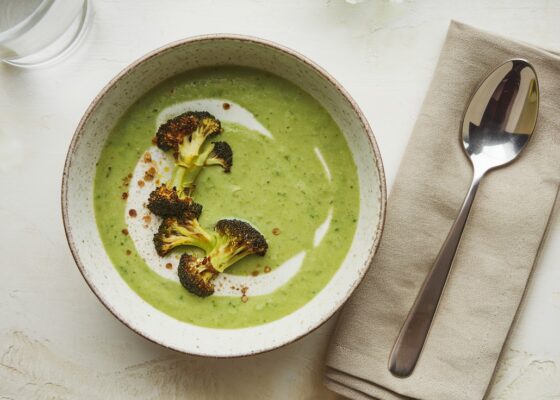
Brown rice contains 49 grams of net carbs per cooked cup, making it challenging to incorporate into most low-carb diets. While it offers valuable nutrients, including fiber, B vitamins, and minerals that support metabolic health, its high carbohydrate content requires careful portion control. Those following strict low-carb plans may need to limit or avoid brown rice, though moderate-carb dieters can include small portions of a half-cup or less. Understanding portion sizes and alternatives can help determine the best approach.
Key Takeaways
- Brown rice contains 49 grams of net carbs per cup, making it challenging to include in most low-carb diets that restrict daily carbs.
- Portion control is crucial; a half-cup serving provides 26 grams of net carbs, which may fit moderate low-carb diets.
- Lower-carb alternatives like cauliflower rice (5g net carbs) or shirataki rice (1g net carbs) are better options for strict low-carb diets.
- Brown rice's fiber content and nutrients offer health benefits, but its high carb content makes it unsuitable for ketogenic diets.
- Individual carb tolerance varies, so some may include small portions of brown rice while maintaining their low-carb goals through careful planning.
The Carbohydrate Content of Brown Rice
Brown rice presents a nutritional dichotomy for those following a low-carb diet, containing 52 grams of carbohydrates per cooked cup. While this whole grain offers beneficial nutrients and dietary fiber, with 3 grams per cooked cup, its carbohydrate content poses challenges for strict carb restriction plans.
The glycemic index of brown rice is considerably lower than white rice, offering some advantage in blood sugar management. Studies suggest switching to brown rice may reduce diabetes risk by up to 16%.
However, portion control remains essential for those monitoring their carbohydrate intake, as even healthy whole grains can greatly impact daily carb limits. Understanding these nutritional aspects helps individuals make informed decisions about incorporating brown rice into their low-carb eating plans.
Understanding Net Carbs vs. Total Carbs
When considering brown rice in a low carb diet, understanding the distinction between net carbs and total carbs becomes essential for accurate meal planning.
The calculation of net carbs involves subtracting the fiber content from total carbohydrates, which for brown rice means deducting 3 grams of fiber from the 52 grams of total carbs per cooked cup, yielding 49 grams of net carbs.
This calculation method helps dieters better assess the true impact of brown rice on blood sugar levels, as fiber passes through the digestive system without significant metabolic effects.
Calculating Net Carb Content
Understanding the difference between net carbs and total carbs is essential for anyone following a low-carb diet, particularly when incorporating foods like brown rice into their meal plans.
When calculating net carbs, individuals must subtract the fiber content from total carbohydrates, as fiber doesn't affect blood sugar levels.
For those monitoring carb intake, here's how to calculate net carbs in brown rice:
- Identify total carbohydrates (52g per cooked cup)
- Determine fiber content (3g per cooked cup)
- Subtract fiber from total carbs (52g – 3g = 49g net carbs)
Brown rice offers a slight advantage over white rice due to its higher fiber content, though both should be consumed in moderation on a low carb diet.
This calculation method helps individuals better manage their carbohydrate intake while maintaining dietary goals.
Fiber's Impact on Carbohydrates
Dietary fiber plays an important role in how carbohydrates affect the body, particularly in relation to blood sugar levels and overall carbohydrate processing.
When calculating net carbs in whole grains like brown rice, understanding fiber's impact is vital for those following a low carb diet. While brown rice contains 52 grams of total carbohydrates per cooked cup, its 3 grams of fiber reduce the net carbs to 49 grams.
The fiber content in brown rice greatly affects glucose absorption, creating a slower release of sugars into the bloodstream compared to refined grains.
This mechanism allows for better blood sugar control, making portion sizes critical when incorporating brown rice into a low carb eating plan. By accounting for fiber's effects, individuals can make more informed decisions about including whole grains in their diet.
Health Benefits Beyond the Carb Count
While brown rice contains more carbohydrates than many low-carb foods, its rich nutrient profile includes essential vitamins, minerals, and antioxidants that support overall health and wellness.
The presence of powerful compounds like cycloartenyl ferulate helps combat inflammation and maintain cardiovascular health, making brown rice a valuable dietary component despite its carbohydrate content.
Research indicates that incorporating moderate amounts of brown rice into a balanced diet can help regulate blood sugar levels naturally, with studies showing a significant reduction in diabetes risk when substituting it for white rice.
Packed With Essential Nutrients
The nutritional powerhouse of brown rice extends far beyond its carbohydrate content, offering an impressive array of essential nutrients that support overall health and wellness. This whole grain retains its natural bran and germ layers, delivering significant nutritional benefits for those monitoring their carbohydrate intake.
Key nutritional highlights include:
- Rich calcium, iron, and magnesium content, along with B vitamins, supporting overall metabolic health
- Approximately 3 grams of fiber per cooked cup, aiding digestion and weight management
- Powerful antioxidants like cycloartenyl ferulate, which help reduce cholesterol levels and inflammation
These nutrients work synergistically to promote cardiovascular health, support blood sugar control, and reduce the risk of type 2 diabetes, making brown rice a valuable addition to a balanced diet despite its higher carb content.
Fights Disease and Inflammation
Beyond its impressive nutritional profile, brown rice stands out as a powerful ally in fighting disease and reducing chronic inflammation throughout the body.
Research demonstrates that compounds like cycloartenyl ferulate work actively to lower cholesterol and support heart health, while the grain's high fiber content helps manage blood sugar levels, potentially reducing type 2 diabetes risk.
Regular consumption of this whole grain contributes to a robust immune system through its support of gut health and microbiome balance.
Studies indicate that incorporating brown rice into one's diet, even while following a low carb approach, can reduce heart disease risk by up to 21%.
The grain's anti-inflammatory properties, combined with essential nutrients like magnesium and B vitamins, make it a valuable addition for those seeking to prevent chronic diseases while maintaining metabolic health.
Natural Blood Sugar Control
Despite its carbohydrate content, brown rice serves as a natural regulator of blood sugar levels, making it a viable option even for those monitoring their glucose intake.
The high fiber content of this whole grain plays an essential role in supporting healthy blood sugar levels through improved insulin sensitivity and slower glucose absorption.
Research highlights three key benefits for blood sugar control:
- Lower glycemic index compared to white rice, resulting in steadier glucose release
- Contains approximately 3 grams of fiber per cooked cup, supporting digestive health
- Associated with a 16% reduction in diabetes risk through improved metabolic function
These advantages, combined with brown rice's antioxidant properties and cardiovascular health benefits, make it a thoughtful addition to a balanced low carb diet focused on long-term health outcomes.
Brown Rice Alternatives for Low Carb Diets
While brown rice remains a popular whole grain choice, individuals following low carb diets can find excellent alternatives that dramatically reduce their carbohydrate intake without sacrificing texture or satisfaction. For those strictly limiting their carbs, cauliflower rice presents a compelling option with just 5 grams of net carbs per cup, compared to brown rice's 52 grams. Zucchini noodles and shirataki rice offer even lower carb counts, at 4 and 1 grams respectively, making them ideal substitutes. Including non-starchy vegetables like spinach and kale in meals can further support low carb goals while providing essential nutrients. Those following more moderate low carb approaches might consider quinoa, with 34 grams of net carbs, or bulgur, containing 26 grams per cup. These alternatives provide varying levels of carbohydrate reduction while maintaining the versatility needed for creating satisfying meals.
Portion Control Strategies for Rice Consumption
Successful brown rice consumption on a low carb diet depends heavily on precise portion control and measurement techniques.
Using a food scale guarantees accurate portions of 100 grams cooked rice, providing approximately 23 grams of net carbs per serving, while measuring cups can help maintain consistent half-cup portions containing 26 grams of net carbs.
These measurement strategies, combined with mindful plating practices such as using smaller dishes or filling half the plate with non-starchy vegetables, help maintain portion control while incorporating brown rice into a low carb eating plan.
Measure Rice With Care
Three essential strategies for measuring brown rice portions can help individuals maintain their low-carb dietary goals without completely eliminating this nutritious grain.
When incorporating brown rice into a healthy diet, precise measurement becomes vital for managing carbohydrate intake and achieving ideal portion sizes.
- Use a kitchen scale to measure exactly 100 grams of cooked brown rice, containing 52 grams of carbs.
- Measure a standard half-cup serving, which provides approximately 26 grams of net carbs.
- Follow the plate method by dividing meals into 50% vegetables, 25% protein sources, and 25% brown rice.
Tracking portions through a food diary guarantees accountability while maintaining balanced nutrition.
This systematic approach allows individuals to enjoy brown rice while adhering to their low-carb lifestyle through controlled portions and thoughtful meal structure.
Smart Rice Serving Methods
Mastering smart rice serving methods enables individuals to enjoy brown rice while maintaining their low-carb dietary goals through effective portion control strategies.
The recommended serving size of 1/2 cup cooked brown rice, containing 26 grams of net carbs, provides a manageable portion for those monitoring carbohydrate intake.
Implementing the plate method offers a structured approach, where non-starchy vegetables occupy half the plate, while brown rice and protein sources each take up a quarter.
Combining brown rice with high-fiber foods and healthy fats helps moderate blood sugar control and enhances satiety.
To maintain consistent portion control, preparing larger batches of brown rice and freezing individual servings proves particularly effective, ensuring precise measurements during meal preparation while saving time.
Glycemic Impact and Blood Sugar Response
Understanding blood sugar response is essential when incorporating brown rice into a low-carb diet, as its glycemic impact differs greatly from refined grains. The fiber content in brown rice plays a vital role in moderating carbohydrate absorption and stabilizing blood sugar levels, making it a more suitable option for those monitoring their glucose response.
Research demonstrates significant benefits for blood sugar management:
Scientific studies reveal that managing blood sugar becomes more effective when incorporating the right dietary choices in your meal planning.
- Brown rice contains approximately 3 grams of fiber per cooked cup, helping slow glucose absorption.
- Regular consumption can reduce type 2 diabetes risk by 16% when substituted for white rice.
- The natural fiber envelope around carbohydrates contributes to lower insulin resistance.
This slower release of glucose translates to more stable energy levels throughout the day, without the dramatic spikes typically associated with refined grain consumption.
Nutritional Profile and Micronutrients
While blood sugar management remains a key consideration, the nutritional composition of brown rice extends far beyond its glycemic effects. As a whole grain, brown rice maintains its bran and germ layers, which house an impressive array of essential nutrients, including B vitamins, magnesium, and iron, setting it apart from refined alternatives on a low carb diet.
The nutritional profile of brown rice is enhanced by its fiber content, providing 3 grams per cooked cup, which supports digestive health and promotes feelings of fullness.
Additionally, this grain contains beneficial antioxidants, particularly cycloartenyl ferulate, which has been linked to reduced inflammation and improved cholesterol levels.
These compounds, combined with the fiber's ability to regulate blood sugar levels, make brown rice a nutrient-dense option for those carefully managing their carbohydrate intake.
Fitting Brown Rice Into Different Low Carb Plans
Despite its higher carbohydrate content, brown rice can be strategically incorporated into various low carb eating plans through careful portion control and thoughtful meal planning.
With 52 grams of net carbs per cooked cup, it's essential to contemplate different approaches based on individual dietary goals.
Here are key strategies for including brown rice in a low carb diet:
- Substitute brown rice for higher-carb alternatives while maintaining proper portion sizes
- Pair brown rice with high-fiber foods to balance overall meal carbohydrates
- Use as an occasional addition rather than a daily staple
Those following a very low carb or ketogenic diet may need to avoid brown rice entirely, while individuals on moderate low carb plans can include small portions to maintain a balanced nutrient profile without exceeding their daily carbohydrate limits.
Preparing Brown Rice to Reduce Carb Impact
The preparation method of brown rice can greatly impact its carbohydrate content and overall effect on blood sugar levels. Strategic preparation techniques can help reduce carb impact while maintaining nutritional benefits.
Soaking brown rice before cooking serves two purposes: it helps reduce arsenic content and decreases cooking time, making it more practical for meal prep.
To further lower glycemic index, rinse the rice thoroughly and cook it in excess water before draining. Using a pressure cooker not only reduces cooking time but also helps preserve nutrients.
For best results, combine prepared brown rice with high-fiber foods like vegetables or legumes, which helps moderate the carbohydrate load while maximizing nutritional value.
These preparation methods enable individuals following low-carb diets to incorporate brown rice more effectively into their meal plans.
Who Should Consider Brown Rice Alternatives
Several distinct groups of individuals should carefully evaluate their consumption of brown rice and consider suitable alternatives for their dietary needs.
Those following a low carb diet or managing blood sugar levels may find brown rice's high carbohydrate content challenging to incorporate into their meal plans.
Managing blood sugar or low-carb diets requires careful consideration of brown rice due to its significant carbohydrate content.
Key groups who should explore brown rice alternatives include:
- Individuals following ketogenic or very low carb diets (under 50g daily carbs)
- Diabetics seeking better blood sugar control through lower glycemic options
- People pursuing weight loss goals while maintaining a low carb lifestyle
For these groups, alternatives like quinoa offer more protein with fewer net carbs, while cauliflower rice provides a low-carb substitute.
Those with gluten sensitivity can also benefit from these alternatives, which naturally align with their dietary restrictions while supporting their health goals. Regular blood sugar monitoring is crucial for diabetics on a low-carb diet to avoid hypoglycemia and ensure effective management.
Research-Backed Effects on Weight Management
Scientific research has revealed compelling evidence supporting brown rice's role in effective weight management, though its high carbohydrate content presents challenges for strict low-carb dieters.
Studies demonstrate that incorporating whole grains like brown rice into one's diet correlates with a 16% reduced risk of obesity compared to consuming refined grains.
The high fiber content in brown rice, at approximately 3 grams per cooked cup, promotes satiety and helps maintain stable blood sugar levels through slower glucose release.
This combination of benefits can lead to reduced overall calorie intake and improved weight management outcomes.
Research specifically shows that replacing refined grains with brown rice can result in decreased body weight and waist circumference, making it a valuable consideration for those balancing weight management goals with moderate carbohydrate intake.
Frequently Asked Questions
Can Brown Rice Be Part of a Low-Carb Diet?
Brown rice can fit within low-carb diets through careful portion control. Its fiber content offers benefits, but health considerations may warrant selecting lower glycemic index alternatives when following strict meal planning preferences.
Does Brown Rice Count as a Grain?
Brown rice is a whole grain containing intact bran, germ, and endosperm. Its nutritional profile includes fiber, vitamins, and minerals, making it a valuable member of the diverse grain family.
What Is the Lowest Carb Grain to Eat?
Among common grains, air-popped popcorn contains the lowest net carbs at 6 grams per cup, making it a better choice than quinoa, barley, oats, millet, buckwheat, amaranth, spelt, or farro.
Should I Avoid Brown Rice to Lose Weight?
Successful weight loss depends on overall caloric intake and meal planning. While brown rice provides dietary fiber and energy levels, portion control is essential. Consider lower carbohydrate count alternatives for more efficient weight management.
Conclusion
While brown rice contains more carbohydrates than strict low-carb diets typically allow, it can be incorporated into moderate low-carb eating plans through careful portion control and strategic meal timing. Its nutritional benefits, including fiber, minerals, and antioxidants, make it a valuable consideration for those following flexible approaches. Individuals should weigh their specific dietary goals, carbohydrate tolerance, and overall health objectives when deciding whether to include brown rice in their low-carb lifestyle.










No Comments